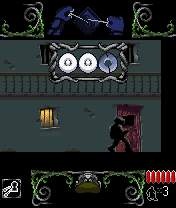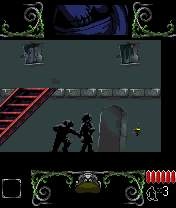Ion Storm's hugely successful first-person-shooter series may be the progenitor of the stealth genre, but it has been well beaten to the mobile format by Gameloft's excellent Splinter Cell translations. Finally, however, the first episode in a miniaturized Thief series has arrived, and as with the Tom Clancy titles, it has been transformed into a 2D platformer, where traditional run-and-jump gameplay collides with modern stealth techniques.
The plot pretty much follows the PC version of Deadly Shadows, wherein master thief Garrett has been employed by the shadowy Keepers who seek to maintain order in a fractious city where magic coexists with machinery--a sort of steampunk Middle-earth. Through several steal-and-run missions, Garrett must recover gems and other valuable items from various rich and corrupt denizens to somehow prevent an approaching Dark Age. The story moves forward by overheard snatches of conversation between other characters--only here they appear as subtitles rather than actual dialogue. Gone are the rich, multilayered soundscapes of the PC titles. Garrett has cruder tools to work with now.

Sensibly, Thief has been radically overhauled to take the difficult interface of the mobile phone into consideration. Left and right on your joypad control movement, while an action button (the five key) covers everything from jumping and attacking to going through doors and using staircases, depending on what's appropriate at the time. Zero is the only other key, and this allows Garrett to duck down and remain unseen (he can also pick pockets while in this position, the cheeky scamp). The up and down buttons cycle through Garrett's sizable inventory of weapons.
Stealth still plays an important role in the game, of course. When Garrett emerges from the shadows into a position where he's potentially visible to enemies, the whole screen lights up and you get a stab of music, which is a nice system that's much more obvious, and alarming, than the usual tiny light meter. Going through doorways is a two-phase activity. First of all, hitting the action button lets you prize the door ajar and sneakily peek through to check for guards; hitting it again lets you slip through. This feeds in well with the generally more-cautious pace of the Thief gameplay.
Action revolves around exploring a series of gothic mansions, churches, castles, and the like, as well as finding keys, stealing loot, bashing guards, and picking locks to gain entry to new areas. The latter element works as a simple memory minigame, in which you get a series of lock barrels that are triggered if you push them in the right direction; you just have to find and remember the correct sequence. Disappointingly, there were very few occasions where we were pressured into carrying out this task quickly before being discovered, which would have brought some tension to the proceedings.
At first, the game looks a bit disappointing on the Nokia 6600, as the locations are rather small, and, graphically, they're not interesting or diverse enough to make the exploration element particularly compelling. Once you've seen one torch-lit stone corridor, you've pretty much seen them all. Also, when Thief is compared to Splinter Cell, with its razor-sharp detail, scenic variety, and wealth of often humorous background animations, it all feels a little lifeless. Things improve greatly as you progress through the missions, however. There are little scenic touches, like the bell tower in the church, the dense woodland behind the Black Bull Inn, and the several hidden rooms and cubbyholes littered throughout the levels--all of which help to develop the atmosphere even further. It is a reminder of the heady sense of place we've come to love in the PC versions of the game.
Enemy guards become more numerous and more challenging, and so this is where your inventory is brought into play. Pressing up or down on the joypad cycles through a variety of objects, including water arrows (to put out torches), noise arrows, flash bombs, and gas bombs, all of which create diversions or stun opponents. Select the Eye icon and you get a sort of sniper-scope view that you can then move around the level to check for soldiers. This feature is very useful when you're down to your last energy point. Hand-to-hand combat is messy and unpredictable, and it is best avoided.
There are some simple little puzzles in there to flesh out the experience. Mostly you'll need to locate hidden chambers using the map (which you can usually acquire from a downed guard). However, there is one puzzle involving a fireplace, which you think is a hint at more-trying problems to come, but it turns out to be something of a one-off. Still, with the later, more-labyrinthine environments, there's always the chance of finding a few hidden jewels or overhearing a snippet of conversation, so it's fun to wander around and explore every crevice.

At the end of each mission you get a stats screen, listing figures such as locks picked, loot stolen, times caught, and so on. Later, you can go back in single-mission mode and try to improve your haul. After the stats, you get the chance to visit your fence (after a repetitive roof-running minigame) to buy fresh supplies with which to restock your inventory.
Eight missions later, and Thief: Deadly Shadows Episode One is all over, leaving you with a cliff-hanger for the next and concluding installment. We finished the game in around three hours, but we're already tempted to go back and locate some of the loot we missed the first time around. Taken as a 2D platformer, this is a diverting little adventure, more varied than Iomo's Tomb Raider trilogy, but--fittingly for Garrett--very much in the shadow of the Splinter Cell titles. This game is a solid download all the way around, and recommended for fans of stealth-action gameplay.